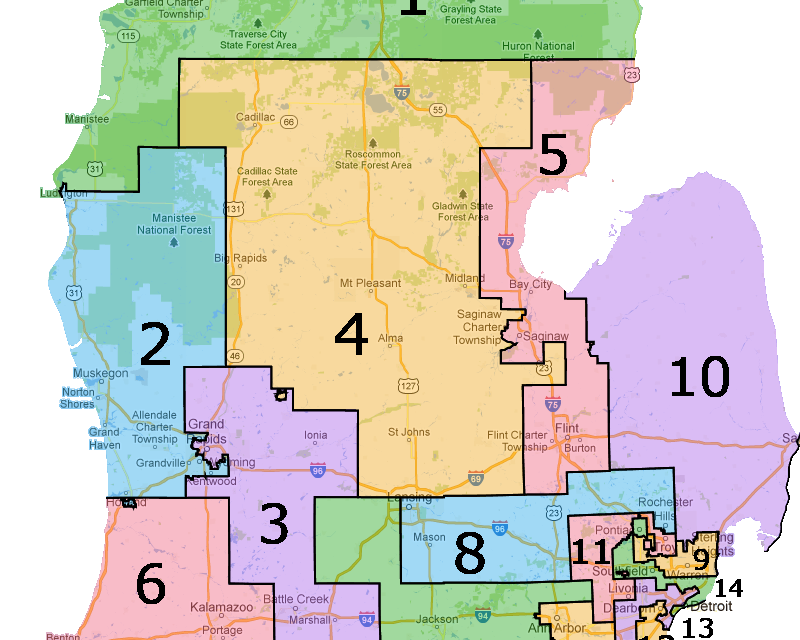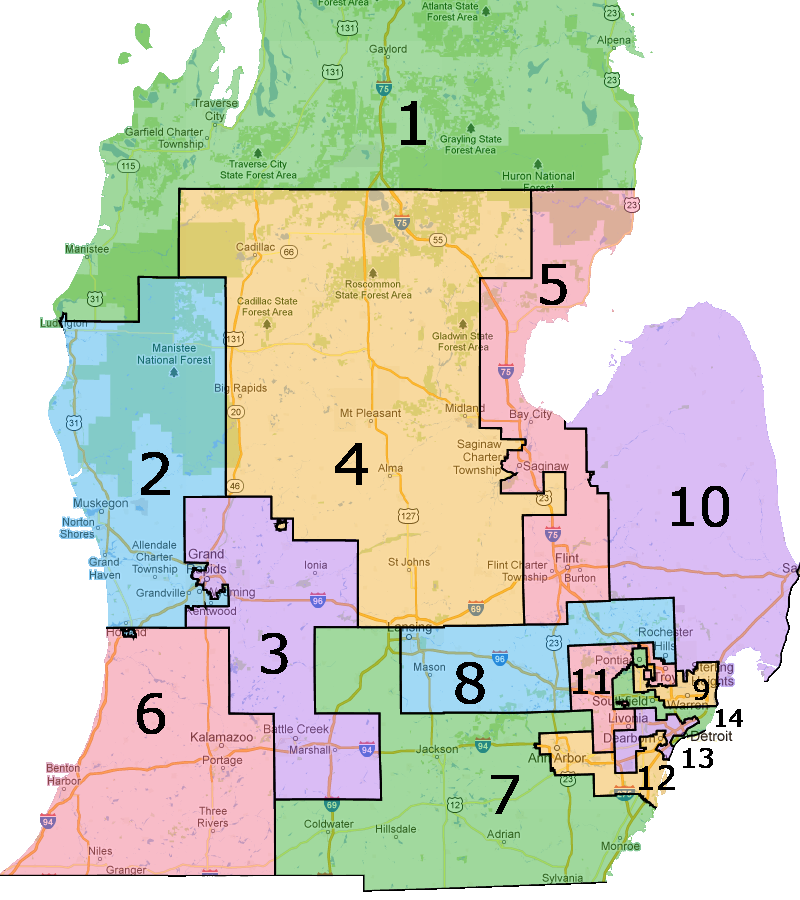Now that the Republicans in Lansing have abandoned a nefarious plan to manipulate Michigan’s presidential elections, it’s time for the Democrats who have expressed outrage over this scheme to concede that they have participated in a system that rigged elections for Congress and the Legislature for decades.
And it’s time for average, disillusioned voters to stop these partisan games by putting forward a ballot proposal that ends the devious process of gerrymandering legislative districts.
The Michigan electorate deserves a chance to create the same kind of independent commission that presides over the nonpartisan drawing of districts as exists in several states.
After the stunning numbers that came out of the Nov. 4 general election – with votes skewed to a ridiculous extent in favor of the Republicans – it seems clear that redistricting reform should be near the top of every voter’s list.
It’s also abundantly clear that both political parties will do everything in their considerable power to stop such an effort.
The controversial GOP plan for presidential elections, previously put forward with a breathtaking amount of hubris by Macomb County’s own Pete Lund, a state representative from Shelby Township, would have allocated Michigan’s Electoral College votes proportionately based on the election results in each congressional district. In other words, this trickery would have relied upon a map drawn by the Republicans in a hyper-partisan manner.
That move would have so bastardized the will of the people that Mitt Romney, who lost the 2102 popular vote in Michigan by a substantial margin to President Obama, would have received a majority of the state’s Electoral College votes.
Lund introduced a new plan last week that seems less partisan, though it oddly seeks to dump the standard winner-take-all approach to elections by dividing up Michigan’s 16 Electoral College votes based on the state’s margin of victory in the presidential race.
This loser-gets-a-share approach is designed to make Michigan a frequent campaign destination for those seeking the Oval Office, altering a system that dates back to 1836 by taking a chamber of commerce travel bureau approach to democracy.
At the same time, the far more egregious issue at the heart of Michigan’s brand of democracy was on full display in the general election. Though Michigan stands as a closely contested state up and down the ballot, most of the electorate lives in non-competitive districts where votes don’t count for much.
The jagged, zig-zagging districts that granted Democrats a clear advantage for many years when they were the majority in the state Capitol are now the product of Republicans in charge. Maybe the GOP is better at this game – or more ruthless – but the high-tech precision in drawing maps has produced a monstrous result.
Here was the outcome in the November election:
* The combined statewide popular vote for state House candidates gave Democrats a 51.2 percent share, but just 43 percent of House seats. As a result, a 56-54 advantage for Democrats that could have occurred in districts that were drawn in an entirely neutral manner was twisted into a 63-47 gap in favor of the GOP.
* The statewide result for state Senate gave the Republicans a 50.7 percent share of votes, but the outcome under Michigan’s gerrymandered districts saw the GOP grab 71 percent of the Senate seats, giving them a gaping split of 27-11 over the Democrats for the next four years.
* And in the elections for seats in Congress, the overall vote gave Democrats the “win” – 49.1 percent to 47.6 percent. But the doctored districts gave the Republicans the victory with a 9-5 edge in U.S. House seats.
Each of those numbers, this poisoning of our politics, is shameful.
They are the product of crimes of geography in which the politicians, whose main motivation is political power and self-preservation, are those who draw the maps. With a bit of good ol’ boy horse-trading thrown in by the party out of power, the final lines that are drawn amount to an incumbent protection plan.
As commentator George Will has said: “The voters don’t choose their representatives, the representatives choose their voters.”
The disingenuous claim by partisans on the left and on the right that a truly neutral, nonpartisan district does not and cannot exist is exactly the kind of noise that will be spread far and wide if a proposal for redistricting reform ever makes it to the ballot.
Anyone who has observed the squiggly district boundaries in North Carolina, for example, and compared them to the lines in Iowa (see map above) surely knows that an objective, nonpolitical approach toward the decennial rite of apportionment imparts a world of difference.
Iowa has emerged as the gold standard, a model of equity, for establishing fairness and objectivity in mapping out districts. In what may be the nation’s most politically charged state, Iowa has nonetheless created four congressional districts that are cleanly drawn to maximize the standards of square and compact shapes.
When the Boston Globe took a first-hand look at Iowa’s impartial approach, here is what they found: “The mapmakers are not allowed to consider previous election results, voter registration numbers, or even the addresses of the incumbent(s). … No politician – not the governor, the (state) House speaker, or Senate majority leader – is allowed to weigh in, or get a sneak preview.”
The result? Each district represents Iowa’s mix of urban and rural flavor. In addition, the Hawkeye State has some of the most competitive congressional elections in the nation.
Drawing 14 compact districts in Michigan would be more difficult given the state’s mitten shape. But California, with many more miles of jagged coastline and 53 congressional districts to work with, is among those states that successfully switched to an independent redistricting commission.
To be fair, outdated apportionment standards established by prior legislation and litigation would have to be challenged in Michigan, but other states have managed.
And, to be sure, Democrats and Republicans would demonize this approach. But what is their source of credibility on this issue? Voter dissatisfaction with incumbents hovers at record highs, yet nearly every incumbent seeking re-election at the congressional or state level won on Election Day. What does that say?
It’s also telling that in the 435-member U.S. House, a bill that would require nonpartisan districting in every state has just three supporters.
If Michigan undertakes a petition drive leading to a ballot proposal, the independents, the moderates, the ticket-splitters – and the good-government reformers – will have to lead the charge. Call it the I’m Not Going To Take It Anymore Coalition.
They will be up against those insiders who seek to protect their illegitimate distribution of power. It’s up to the voters to realize that, when these partisan practitioners slice and dice Michigan’s political landscape, it’s the people of all shapes and sizes who are left wounded.
Related







Instead, The National Popular Vote bill would make every vote, everywhere, politically relevant and equal in presidential elections. No more distorting and divisive red and blue state maps of pre-determined outcomes. There would no longer be a handful of 'battleground' states where voters and policies are more important than those of the voters in 80% of the states, like Michigan, that now are just 'spectators' and ignored after the conventions.
National Popular Vote would guarantee the majority of Electoral College votes, and thus the presidency, to the candidate who receives the most popular votes in the country, by replacing state winner-take-all laws for awarding electoral votes.
The bill would take effect when enacted by states with a majority of Electoral College votes—that is, enough to elect a President (270 of 538). The candidate receiving the most popular votes from all 50 states (and DC) would get all the 270+ electoral votes of the enacting states.
The presidential election system, using the 48 state winner-take-all method or district winner method of awarding electoral votes, that we have today was not designed, anticipated, or favored by the Founders. It is the product of decades of change precipitated by the emergence of political parties and enactment by 48 states of winner-take-all laws, not mentioned, much less endorsed, in the Constitution.
The bill uses the power given to each state by the Founders in the Constitution to change how they award their electoral votes for President. States can, and have, changed their method of awarding electoral votes over the years. Historically, major changes in the method of electing the President, including ending the requirement that only men who owned substantial property could vote and 48 current state-by-state winner-take-all laws, have come about by state legislative action.
In Gallup polls since 1944, only about 20% of the public has supported the current system of awarding all of a state's electoral votes to the presidential candidate who receives the most votes in each separate state (with about 70% opposed and about 10% undecided).
Support for a national popular vote is strong among Republicans, Democrats, and Independent voters, as well as every demographic group in every state surveyed recently. In virtually every of the 39 states surveyed, overall support has been in the 70-80% range or higher. – in recent or past closely divided battleground states, in rural states, in small states, in Southern and border states, in big states, and in other states polled.
Obvious partisan machinations, like those proposed now in Michigan's lame duck session, should add support for the National Popular Vote movement. If the party in control in each state is tempted every 2, 4, or 10 years (post-census) to consider rewriting election laws with an eye to the likely politically beneficial effects for their party in the next presidential election, then the National Popular Vote system, in which all voters across the country are guaranteed to be politically relevant and treated equally, is needed now more than ever.
Americans believe that the candidate who receives the most votes should win.
The bill has passed 33 state legislative chambers in 22 rural, small, medium, large, red, blue, and purple states with 250 electoral votes. The bill has been enacted by 11 jurisdictions with 165 electoral votes – 61% of the 270 necessary to go into effect.
NationalPopularVote
Instead, a survey of Michigan voters showed 73% overall support for a national popular vote for President, that would make Michigan more important in presidential elections, and would force the candidates wanting to win to be concerned about Michigan.
Support was 73% among independents, 78% among Democrats, and 68% among. Republicans.
By age, support was 77% among 18-29 year olds, 67% among 30-45 year olds, 74%. among 46-65 year olds, and 75% for those older than 65.
By gender, support was 86% among women and 59% among men.
As recently as December 11, 2008, The Michigan House of Representatives passed the National Popular Vote bill by a 65-36 margin.
NationalPopularVote
There's a petition against the attempt now in Michigan to rig the Electoral College
To Make Sure Every Vote Counts
http://site.pfaw.org/site/PageServer?pagename=GOPElectionRigging&autologin=true
Popular vote would make all but the most populous states irrelevant.
The entire purpose of the Electoral College is to prevent the fraudulent election results that are ubiquitous in systems that use the Popular vote. A Popular vote would establish a system that’s far more conducive to effectively manipulating the necessary quantities of votes that’s necessary to effect a fraudulent election result. The Democrats would only have to establish their network of criminals in the top five populous states in the Country to steal elections, instead of, being forced to work their deceitful plan over the entire nation.
The implementation of a popular vote would effectively destroy the most successful Republic ever known to mankind, instead, we would become a nation doomed to the repetition of histories most tragic failed states and world powers